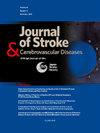Circulating Mucosal-associated Invariant T Cells Predict Early Neurological Deterioration in Acute Ischemic Stroke
IF 2
4区 医学
Q3 NEUROSCIENCES
Journal of Stroke & Cerebrovascular Diseases
Pub Date : 2025-03-27
DOI:10.1016/j.jstrokecerebrovasdis.2025.108301
引用次数: 0
Abstract
Background
Mucosal-associated invariant T (MAIT) cells are innate-like T cells that rapidly produce cytokines such as tumor necrosis factor-α (TNF-α) and interleukin-17 (IL-17) upon activation. The immune response is crucial in stroke-related injury. However, few studies have investigated the role of MAIT cells in ischemic brain injury. This study assessed the predictive value of circulating MAIT cells in acute ischemic stroke (AIS) and early neurological deterioration (END).
Methods
We prospectively and continuously enrolled AIS patients within 72 h of stroke onset and included controls. END was defined as a ≥2-point increase in the National Institutes of Health Stroke Scale score within the first 72 h. Receiver operating characteristic curves were used to evaluate the predictive value of MAIT cells for END.
Results
This study included 188 AIS patients and 135 controls, with 50 (26.6%) AIS patients experiencing END. After adjusting for all potential confounders, circulating MAIT cell frequencies were lower in AIS patients than in controls (odds ratio [OR]: 0.83, 95% confidence interval [CI]: 0.70–0.97, P = 0.02). IL-17 and TNF-α levels were significantly higher in AIS patients and negatively correlated with MAIT cell frequencies (R = −0.26, P < 0.05; R = −0.19, P < 0.05). Multivariate logistic regression analysis revealed that MAIT cell frequencies were lower in patients with END compared to those without END (OR: 0.74, 95% CI: 0.55–0.96, P = 0.03). The area under the curve for MAIT cells in END prediction was 0.641 (95% CI: 0.548–0.725, P < 0.05).
Conclusions
MAIT cell frequency was reduced in AIS patients and may serve as a predictive marker for END. Modulating these cells could be a novel AIS treatment strategy.
循环粘膜相关不变T细胞预测急性缺血性卒中早期神经功能恶化。
背景:粘膜相关不变性 T 细胞(MAIT)是一种先天性 T 细胞,激活后可迅速产生肿瘤坏死因子-α(TNF-α)和白细胞介素-17(IL-17)等细胞因子。免疫反应对中风相关损伤至关重要。然而,很少有研究调查 MAIT 细胞在缺血性脑损伤中的作用。本研究评估了循环 MAIT 细胞在急性缺血性卒中(AIS)和早期神经功能恶化(END)中的预测价值:方法:我们前瞻性地连续招募了卒中发生后 72 小时内的 AIS 患者,并纳入了对照组。END的定义是在最初72小时内美国国立卫生研究院卒中量表评分增加≥2分。结果:该研究纳入了188名AIS患者,并纳入了对照组:这项研究包括188名AIS患者和135名对照组患者,其中50名(26.6%)AIS患者出现END。在调整了所有潜在的混杂因素后,AIS 患者的循环 MAIT 细胞频率低于对照组(几率比 [OR]:0.83,95% 置信区间 [CI]:0.70-0.97,P = 0.02)。AIS患者的IL-17和TNF-α水平明显较高,且与MAIT细胞频率呈负相关(R = -0.26,P < 0.05;R = -0.19,P < 0.05)。多变量逻辑回归分析显示,与无END患者相比,有END患者的MAIT细胞频率较低(OR:0.74,95% CI:0.55-0.96,P = 0.03)。END预测中MAIT细胞的曲线下面积为0.641(95% CI:0.548-0.725,P < 0.05):结论:AIS患者的MAIT细胞频率降低,可作为END的预测指标。调节这些细胞可能是一种新的AIS治疗策略。
本文章由计算机程序翻译,如有差异,请以英文原文为准。
求助全文
约1分钟内获得全文
求助全文
来源期刊

Journal of Stroke & Cerebrovascular Diseases
Medicine-Surgery
CiteScore
5.00
自引率
4.00%
发文量
583
审稿时长
62 days
期刊介绍:
The Journal of Stroke & Cerebrovascular Diseases publishes original papers on basic and clinical science related to the fields of stroke and cerebrovascular diseases. The Journal also features review articles, controversies, methods and technical notes, selected case reports and other original articles of special nature. Its editorial mission is to focus on prevention and repair of cerebrovascular disease. Clinical papers emphasize medical and surgical aspects of stroke, clinical trials and design, epidemiology, stroke care delivery systems and outcomes, imaging sciences and rehabilitation of stroke. The Journal will be of special interest to specialists involved in caring for patients with cerebrovascular disease, including neurologists, neurosurgeons and cardiologists.
 求助内容:
求助内容: 应助结果提醒方式:
应助结果提醒方式:


